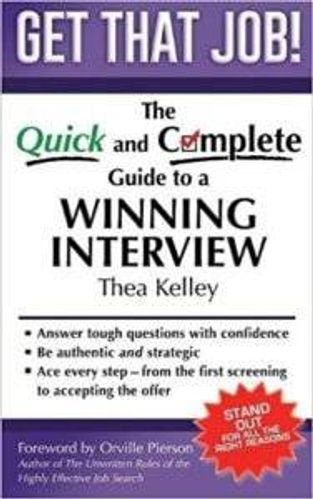The No. 1 Way to Nail a Job Interview
How to tell SOAR stories demonstrating your value to an employer
Early in my career, I was responsible for staffing up a new department store. More than 200 jobs needed to be filled quickly, so I sometimes conducted 20 job interviews in a day. It was a crazy time, but one that taught me a valuable lesson about what separates a good job interview performance from a great one.
Here’s what I learned: Most candidates are qualified. Most come to the interview prepared with answers to likely questions. But the candidate who uses compelling stories to demonstrate his or her value is the one who’s most likely to win the job.
Fortunately, you don’t need to be Garrison Keillor to master this skill. An excellent book, Get That Job! A Quick and Complete Guide to a Winning Interview by career coach Thea Kelley features a step-by-step approach to crafting winning interview stories. The book is a short read, but it overflows with smart tips for navigating every phase of the interview process, from the initial prep to accepting an offer.
The Three Cs of a Job Interview
Before getting into Kelley’s suggestions, I’d like to mention the three unspoken questions — commonly known as the Three Cs of Interviewing — that need to be answered in every interview:
Competence: Do you have the skills, experience and knowledge to do the job, and do it well?

Compatibility: Do you fit with their company culture, especially if it’s significantly different from where you’ve worked before?
Chemistry: Are you someone the employer would like to work with? Businesses, government agencies and nonprofits want to be convinced that their people will enjoy spending a big chunk of their waking hours with you, day after day, in good times and bad.
So, which types of stories best convey this critical information? Ones that tell an employer about a challenge you faced, the actions you took to solve it and the results you achieved. Kelley uses the acronym SOAR (Situation, Obstacles, Actions, Results) to describe this framework.
When using SOAR stories, you don’t just tell an employer “I’m a good manager” or “I’m resilient,” you show it. That feels genuine. Done well, SOAR stories help convince employers that you’re likeable, competent and the best fit for the job.
Here’s a SOAR example excerpted from Kelly’s book from “Rob” talking about how he implemented the business management software, “SuccessSuite.” Note that it takes just a few sentences for Rob to convincingly and clearly convey his value:
Situation: “At the Cooper Company, I realized our business management software wasn’t helping us work efficiently.”
Obstacle(s): “Management initially said SuccessSuite was too expensive. I prepared a presentation that changed their minds.”
Actions: “I researched the options, selected SuccessSuite, learned it, helped configure it and trained our staff on it.”
Results: “Efficiency was increased by 40 percent.”
How to Prepare SOAR Stories
Kelley recommends you prepare 20 stories or more, so you won’t run short if you go through multiple interviews at the same company. That sounds like a lot, and it is, but here are three ways to quickly come up with a good list:
Study relevant job postings. For each experience or skill mentioned, ask yourself: “What have I done or how have I demonstrated that successfully in the past?” Add those stories to your list.
Collect stories from your resumé, LinkedIn profile and performance evaluations. All of these sources have information that can be crafted into relevant stories.
Create question-and-story flashcards that answer common interview questions. Get a bunch of 3 x 5 cards and on one side write a common behavioral interview question like: “Tell me about a time you had to manage a difficult boss.” Then, on the flip side, write down two or three stories that could answer that question.
Once you’ve come up with a master list, format and type-up your stories using the SOAR framework. Kelley’s tips for strengthening each of the SOAR elements:

Situation: Highlight pain points that resonate with employers, such as situations that had caused wasted time, lost money or missed opportunities before you came to the rescue. Keep this section brief, since it just sets the scene for the next three parts, which are more important.
Obstacles: See if you can think of how you helped your employer overcome a big obstacle, like an economic downturn, a microscopic budget or an aggressive deadline. This makes your story more impressive.
Action: Give just enough detail, without getting too granular. Err on the side of brevity; nobody needs to know every draft you wrote in preparing your big speech. Later, you can always fill in with more information, if the interviewer requests it.
Results: This is the part that impresses employers most, so be specific and quantify your impact. It’s best to use impressive numbers or percentages. But if you can’t, use words like significantly, substantially or dramatically. And if a boss said something memorable about your accomplishments, or your action resulted in an accolade or award, include that as well.
After you’ve completed your outlines, highlight the skills and strengths demonstrated in each story. That way, you’ll know exactly which story to share when an employer says something like: “Tell me about a time that you dealt with a difficult co-worker” or “Tell me more about your software expertise.”
Practice Makes Perfect
No matter how carefully crafted your stories, they’ll likely fall flat if you don’t practice your delivery. So…
Practice different versions of the same story. Sometimes you’ll have ample time; others, you’ll need to make it short. Kelley recommends cutting the story down until you can say it in 15 seconds or less. Then, prepare a longer version in case time permits.
Practice in front of a mirror or take a selfie video to see and hear how you’re doing. Then, practice with a buddy or coach, ask for feedback and implement it.
Finally, schedule practice sessions. Start with a brief period of time, like 30 minutes. Set a timer and when the timer rings, you’re done.
Follow these steps, and hopefully, the next story you write will be about your job search success!
Next Avenue Editors Also Recommend:


